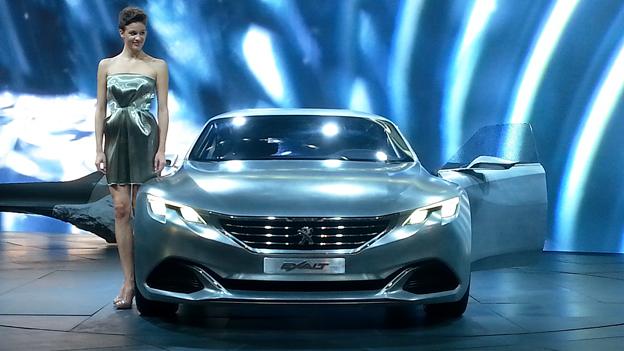The cool cars that money can't buy
- Published

Citroen revealed its latest concept car, the DS Divine, in Paris
An eager crowd gathers, coloured lights blaze, and everyone stares eagerly at the mysterious shape concealed beneath dark covers at the centre of the stage.
Thumping music reaches a crescendo, the covers are removed with a dramatic flourish to reveal… what is actually a fairly dull and nondescript new car. A middle-aged man in a suit then tells us all about it, at some length.
This is a fairly common experience at the major international motor shows. But every now and then, you do see a machine that is truly striking, truly unique, that sets your pulse racing. Invariably, it's a concept car.
These are one-off designs which wow the crowds, but which will never actually be put on sale. More often than not, they don't even work.
Steal the headlines
So what exactly are they for?
"It's a very competitive business, so if you've got a really good concept, that's a way to grab some attention, get some press coverage," says editor of industry website JustAuto.com, David Leggett (no relation to me).
Among the cars grabbing the headlines at the Paris Motor Show is the Q80, a super-luxurious concept car produced by Infiniti.
Over on the Infiniti stand, that theory is being put to the test.
The Japanese brand has brought along its new Q80 concept. It's a sleek, streamlined affair, elegant on the outside and strikingly opulent on the inside.
According to its designer, Alfonso Albaisa, the styling is key to its appeal.
"It's the silhouette. It has a long, sweeping roof that comes to a tapering point," he says. "It gives a romantic classical sense, but the execution I feel is quite modern."
Statement of intent
For him, the car is clearly a work of art. But for Infiniti's product strategy chief, Francois Bancon, it serves a much more pragmatic purpose, as the company sets out to compete directly with upmarket brands such as Aston Martin and Porsche.
"It's a signal we want to deliver to the rest of the industry about the growth of our business, that we're ready to compete with the best of the best," he says.
"We also need to reassure ourselves, check what the reaction is from the media and the public before we go to the next step, which is, sometimes, production."
But concept cars are not only produced to grab headlines. They can also be prototypes, used to demonstrate new technology or manufacturing techniques that are under development.
Theo Leggett looks at the Peugeot 208 Hybrid Air
Peugeot, for example, has brought along its new 208 Hybrid Air. This is a car that has a small, ordinary petrol engine sitting alongside a hydraulic motor that runs on compressed nitrogen.
In theory, the technology has all the benefits of a traditional petrol-electric hybrid, such as reduced fuel consumption during city driving and lower emissions, but without the handicaps.
Because it doesn't need batteries, it can be much lighter than a normal hybrid. It should also be cheaper to buy, and the hybrid system can be recharged much more quickly.
The technology is still several years from going into production, but the high-profile concept shows that Peugeot is serious about developing it.
'Newspaper wood'
Elsewhere, the same company has put its new Exalt on display.

The Exalt, a large luxury sedan with a bare steel body, is striking in appearance
It resembles an updated DeLorean, the car that found fame in the 1980s film Back to the Future.
Unlike the Hybrid Air, it does not look remotely like a real-world prototype - it is clearly more of a headline-grabber.
But design director Gilles Vidal says it has been used as a test bed for new materials that the company does intend to use on its production models.
"We have what we call newspaper wood. We turn old newspapers into blocks of wood-like material, which we can then use to sculpt new pieces for the car's interior.
"It's a very technically efficient, environmentally efficient process, and poetic at the same time," he says.
What's the reaction?
One of the main reasons for creating concept cars though, is simply to gauge reaction to them. They often include very bold styling or interior designs, which the manufacturers are contemplating using on mainstream models.
Putting those ideas on trial can sometimes help them to avoid potentially expensive mistakes.
"Quite often we're doing concept cars to test reaction from the public," explains Gerry McGovern, design director at Jaguar Land Rover.
"It can be about tonality, a look and feel - is this the right visual direction for our brand to go in? What do you think of it?
"Sometimes we might do something as a concept that's very do-able as a production car, but reaction to it isn't very good, so we don't do it. Or it's too expensive.
"Concept cars are just another tool in the product development process."
So even though many concept cars disappear without trace once they've generated their share of headlines, there is clearly more to them than simple flights of fancy from over-enthusiastic engineers.
What's more, they make motor shows like this one a great deal more interesting.